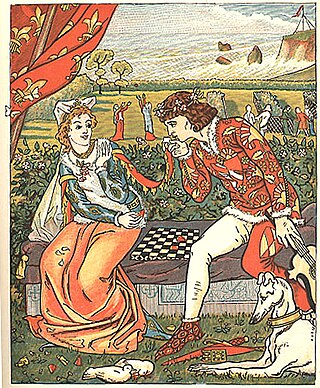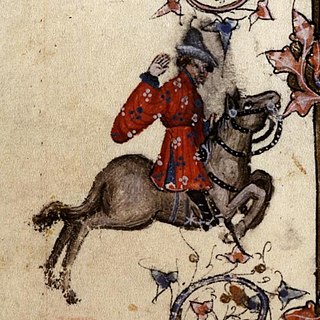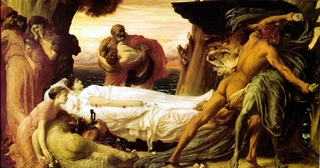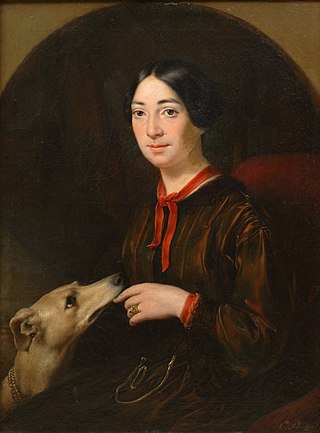Related Research Articles

Proserpina or Proserpine is an ancient Roman goddess whose iconography, functions and myths are virtually identical to those of Greek Persephone. Proserpina replaced or was combined with the ancient Roman fertility goddess Libera, whose principal cult was housed in the Aventine temple of the grain-goddess Ceres, along with the wine god Liber.
In ancient Greek religion and mythology, Pluto was the ruler of the Greek underworld. The earlier name for the god was Hades, which became more common as the name of the underworld itself. Pluto represents a more positive concept of the god who presides over the afterlife. Ploutōn was frequently conflated with Ploûtos, the Greek god of wealth, because mineral wealth was found underground, and because as a chthonic god Pluto ruled the deep earth that contained the seeds necessary for a bountiful harvest. The name Ploutōn came into widespread usage with the Eleusinian Mysteries, in which Pluto was venerated as both a stern ruler and a loving husband to Persephone. The couple received souls in the afterlife and are invoked together in religious inscriptions, being referred to as Plouton and as Kore respectively. Hades, by contrast, had few temples and religious practices associated with him, and he is portrayed as the dark and violent abductor of Persephone.

"The Wife of Bath's Tale" is among the best-known of Geoffrey Chaucer's Canterbury Tales. It provides insight into the role of women in the Late Middle Ages and was probably of interest to Chaucer himself, for the character is one of his most developed ones, with her Prologue twice as long as her Tale. He also goes so far as to describe two sets of clothing for her in his General Prologue. She holds her own among the bickering pilgrims, and evidence in the manuscripts suggests that although she was first assigned a different, plainer tale—perhaps the one told by the Shipman—she received her present tale as her significance increased. She calls herself both Alyson and Alys in the prologue, but to confuse matters these are also the names of her 'gossib', whom she mentions several times, as well as many female characters throughout The Canterbury Tales.

"The Franklin's Tale" is one of The Canterbury Tales by Geoffrey Chaucer. It focuses on issues of providence, truth, generosity and gentillesse in human relationships.

"The Merchant's Tale" is one of Geoffrey Chaucer's Canterbury Tales. In it Chaucer subtly mocks antifeminist literature like that of Theophrastus ("Theofraste"). The tale also shows the influence of Boccaccio, Deschamps' Le Miroir de Mariage, Roman de la Rose by Guillaume de Lorris, Andreas Capellanus, Statius, and Cato. The tale is found in Persia in the Bahar Danush, in which the husband climbs a date tree instead of a pear tree. It could have arrived in Europe through the One Thousand and One Nights, or perhaps the version in book VI of the Masnavi by Rumi. Though several of the tales are sexually explicit by modern standards, this one is especially so. Larry Benson remarks:
The central episode of the Merchant's Tale is like a fabliau, though of a very unusual sort: It is cast in the high style, and some of the scenes are among Chaucer's most elaborate displays of rhetorical art.

"The Reeve's Tale" is the third story told in Geoffrey Chaucer's The Canterbury Tales. The reeve, named Oswald in the text, is the manager of a large estate who reaped incredible profits for his master and himself. He is described in the Tales as skinny and bad-tempered and old; his hair is closely cropped reflecting his social status as a serf. His sword is rusty while he rides a fine gray horse called Scot. The Reeve is a skilled carpenter, a profession mocked in the previous "Miller's Tale". Oswald responds with a tale that mocks the Miller's profession.

Vanessa is an American opera in three acts by Samuel Barber, opus 32, with an original English libretto by Gian Carlo Menotti. It was composed in 1956–1957 and was first performed at the Metropolitan Opera in New York City on January 15, 1958 under the baton of Dimitri Mitropoulos in a production designed by Cecil Beaton and directed by Menotti. Barber revised the opera in 1964, reducing the four acts to the three-act version most commonly performed today.

"The Clerk's Tale" is the first tale of Group E in Geoffrey Chaucer's The Canterbury Tales. It is preceded by The Summoner's Tale and followed by The Merchant's Tale. The Clerk of Oxenford is a student of what would nowadays be considered philosophy or theology. He tells the tale of Griselda, a young woman whose husband tests her loyalty in a series of cruel torments that recall the biblical Book of Job.

"The Shipman's Tale" is one of The Canterbury Tales by Geoffrey Chaucer.

The Canterbury Tales is a 1972 Italian film directed by Pier Paolo Pasolini based on the medieval narrative poem by Geoffrey Chaucer. The second film in Pasolini's "Trilogy of Life", preceded by The Decameron and followed by Arabian Nights, it won the Golden Bear at the 22nd Berlin International Film Festival.

Canterbury Tales is a musical conceived by Martin Starkie and written by Nevill Coghill and Martin Starkie with music by John Hawkins and Richard Hill. Originally presented at the Oxford Playhouse in 1964, it was expanded into a full-length musical and presented at the Phoenix Theatre, London on 21 March 1968. It played for a record-breaking 2080 performances and closed on 24 March 1973.

The loathly lady, is a tale type commonly used in medieval literature, most famously in Geoffrey Chaucer's The Wife of Bath's Tale. The motif is that of a woman who appears unattractive but undergoes a transformation upon being approached by a man in spite of her unattractiveness, becoming extremely desirable. It is then revealed that her ugliness was the result of a curse which was broken by the hero's action.

Alceste, ou Le triomphe d'Alcide is a tragédie en musique in a prologue and five acts by Jean-Baptiste Lully. The French-language libretto is by Philippe Quinault, after Euripides' Alcestis. It was first performed on 19 January 1674 at the Théâtre du Palais-Royal by the Paris Opera.

The Rape of Proserpina, more accurately translated as the Abduction of Proserpina, is a large Baroque marble group sculpture by Italian artist Gian Lorenzo Bernini, executed between 1621 and 1622, when Bernini's career was in its early stage. The group, finished when Bernini was just 23 years old, depicts the abduction of Proserpina, who is seized and taken to the underworld by the god Pluto. It features Pluto holding Proserpina aloft, and a Cerberus to symbolize the border into the underworld that Pluto carries Proserpina into.

Cendrillon is a chamber operetta with dialogue in three acts by Pauline Viardot based on the story of "Cinderella". The work, for a cast of seven with piano orchestration, premiered in Viardot's Paris salon on 23 April 1904, when she was 83, and was published later that year. Inspiration for this work was also found in the small play for children "The Snow Queen" by Nicholay Checkhov based on the tale. Historians are unsure of when the opera was composed, although it is thought to be after the death of Viardot's friend Ivan Turgenev in 1883 as he did not write the libretto. It has been described as "a retelling of the Cinderella story with Gallic wit, Italianate bel canto, and a quirkiness all her [Viardot's] own".
La Spinalba is an opera in three acts, with music by Francisco António de Almeida to an Italian-language libretto whose author is unknown. It was premiered in the Portuguese Carnival season of 1739 at the Palácio da Ribeira, Lisbon.

Stephen Plaice is a UK-based dramatist and scriptwriter who has written extensively for theatre, opera and television. In 2014 he was appointed Writer in Residence at the Guildhall School of Music and Drama. He became Professor of Dramatic Writing at the school in 2018.

The Italian composer Claudio Monteverdi (1567–1643), in addition to a large output of church music and madrigals, wrote prolifically for the stage. His theatrical works were written between 1604 and 1643 and included operas, of which three—L'Orfeo (1607), Il ritorno d'Ulisse in patria (1640) and L'incoronazione di Poppea (1643)—have survived with their music and librettos intact. In the case of the other seven operas, the music has disappeared almost entirely, although some of the librettos exist. The loss of these works, written during a critical period of early opera history, has been much regretted by commentators and musicologists.

Julian Philips is a British composer. Philips' works have been performed at major music festivals, including The Proms, Tanglewood, Three Choirs Festival, at the Wigmore Hall, South Bank Centre and Berlin Philharmonic Chamber Music Hall and by international artists such as Gerald Finley, Dawn Upshaw, Sir Thomas Allen, the Vertavo String Quartet, the Tanglewood Festival Orchestra, the BBC orchestras and the Aurora Orchestra.
Proserpin is a Swedish-language opera by Joseph Martin Kraus to a libretto by the poet Johan Henrik Kellgren following a plot drafted by Gustav III himself from Philippe Quinault's Proserpine. The opera was premiered at Ulriksdal Palace on 6 June 1781 for one performance. The opera was revived at the Drottningholm Theatre in 1980 under Arnold Östman. The opera was performed with a new German libretto at the Schwetzingen Festival in 2006.
References
- ↑ Stephen Plaice & Julian Philips discuss The Tale of Januarie, Front Row, BBC Radio 4, 27 February 2017. Retrieved 5 September 2018.
- ↑ Plaice, Stephen (23 February 2017). "Chaucer, the opera; how to make Middle English sing". The Guardian. Retrieved 5 September 2018.
- ↑ "Work - Edition Peters UK". www.editionpeters.com. Retrieved 24 November 2018.
- ↑ The Tale of Januarie, Peters Edition score.
- ↑ Seymour, Claire (May 2017). "The Tale of Januarie". Opera Magazine.
- ↑ "The Tale of Januarie: Translingualism and Anxietie, Sexuality and Time". 14 March 2017. Retrieved 24 November 2018.
- ↑ "David Wallace - Department of English". www.english.upenn.edu. Retrieved 24 November 2018.